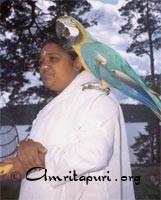26 August 2005, Amritapuri

Amma’s love flows forth to all beings—not just humans. And if one watches the birds that live in and around Amritapuri, one can easily observe that they love her too. Ducks, eagles, owls, crows, pigeons—all have their unique relationship with Amma.
For years there was a beautiful and unusual duck that camped out underneath Amma’s room. He would sit there, beneath her window, almost seeming as if he were meditating. And he never gave up his vigil—even for an hour. And if someone walked up to him, rather than waddle off as most ducks would, he would hold his ground and make them back off with a fierce quack. But he was just one of many.
Each morning, Amritapuri comes alive to the sound of birds. First there are the cuckoos, cooing to each other from distant treetops. They begin quite early—around 3:30 in the morning. They are soon joined by the sweet little voices from a bevy of tiny birds, many of who take up residence in the bushy mango tree by the window to Amma’s room. By the time the sun rises, the chakoras [Greek partridges] have taken over. Flying from one tree to another, several pairs of these brick-red, brown and black birds chatter for about an hour. Then comes a lone red-winged blackbird, a bird of good omen, calling out to all with its deep “grook… grook… grook…” He is followed by the crows, calling out “caw… caw… caw….” Some of the ashram residents like to imagine the birds are all singing just for Amma, calling her to bless them as they begin their day.
Every day, around 8 a.m., a multi-coloured woodpecker, with its fan-like tail-plume, dares to knock at Amma’s window. The ashramites look on amazed—perhaps envious of his view! He knocks first on the eastern panes, hopping around for some time, seeking the best vantage point—and then, if the requested darshan hasn’t come, he goes to the northern panes and continues knocking!
Throughout the day, mynas and pigeons frequently come for Amma’s darshan. They take turns singing for her during darshan, flying in and out of the hall, perhaps longing for a quick glance from their Amma.
Quite frequently, ashram children will bring a wounded baby crow or pigeon to Amma for her blessing, and Amma never fails to kiss the poor baby birds on the head. A painful start to life is thus balanced by a kiss from Amma! Like many of the human devotees, their trauma has become their good fortune. And whenever possible, these injured fledglings will be nursed back to health by the loving care of the ashramites, who keep them in their rooms and even bottle-feed them for weeks on end.
The lotus pond across from Amma’s room is the haunt of a bright blue-winged kingfisher, who occasionally calls out in a shrill voice, perhaps asking Amma to send him a fish—after all, he’s hungry, and isn’t she his mother?
And what to say of the eagles that soar above the Brahmasthanam Temples whenever Amma consecrates them? Across the length and breadth of India, these eagles come to bear witness to the installation of the prana-shakti into the temple’s murti.
For the last six months or so, one eagle—who may indeed be related to the eagle who 30 years ago would drop raw fish into Amma’s lap when she was lost in deep meditation—can almost always be seen somewhere in the ashram. Sometimes he perches on the balcony railing directly behind the temple, only 15 feet from where Amma is giving darshan. But most often he’s found near the Western Canteen, swooping down on unaware devotees to snatch away their buttered toast.
In the evening, when Amma comes for bhajans, the eagle often comes, perching above the stage and then swooping out over the crowd. Not long back, just as Amma had taken her place on her peetham for bhajans, he swooped around the hall several times in what seemed like circumambulation, finally coming inside the stage area in order to circle once more around Amma herself.
During Amritavarsham50, Amma’s 50th birthday celebrations in Cochin, a little owl came to sit right above Amma’s chair for then end of her marathon darshan session, which lasted almost 23 continuous hours. Although a night creature, this little owl stayed by Amma’s side until the late hours of the morning when the sun was burning high in the sky.
A couple of years ago, one of Amma’s devotees gave her a copy of a documentary about birds, which showed amazing close-ups of them as they migrated all over the world. Knowing that her children would love to watch it alongside her, Amma one night called all the ashramites to the bhajan hall in order do so. It was such a treasure—sitting with Amma as she laughed and watched in wonder at her winged friends.
The Upanishads and other Hindu scriptures teach us that the Supreme Consciousness flows equally through everything in this world—be it sentient or insentient, plant or stone, human or animal. The divine spark at the heart of the hummingbird is the same as the one inside each of us, as it is the same as the one inside Amma. But for us, who are caught up in the illusion of maya, created by our ego, it is all too easy to forget this—to ignore the divinity of the play taking place all around us. But wherever we go, and particularly when we spend time in Amma’s ashram, we must struggle to recognize this divine spark in all the creatures that call this world their home—whether they live on land, sea or in the air.
-Tulasi
